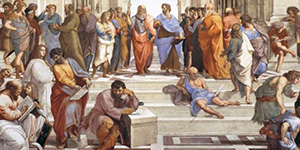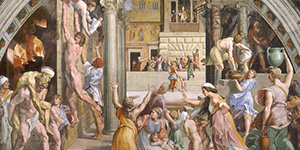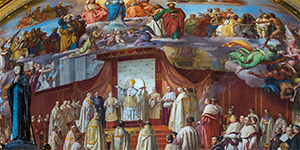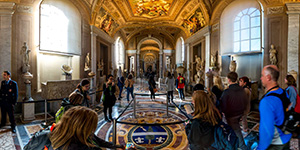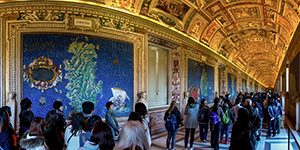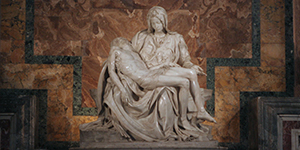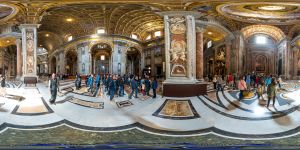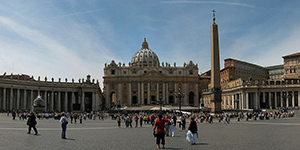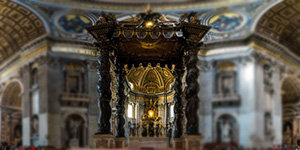

Currently 12 Panoramas in This Gallery
The Vatican Museums (Musei Vaticani) display works from the immense collection built up by the Popes throughout the centuries including some of the most renowned classical sculptures and most important masterpieces of Renaissance art in the world. The museums contain roughly 70,000 works, of which 20,000 are on display. The museums were founded in the early 16th century. The Sistine Chapel, with its ceiling decorated by Michelangelo and the Stanze di Raffaello decorated by Raphael, are on the visitor route through the Vatican Museums.
The Papal Basilica of St. Peter in the Vatican or simply St. Peter's Basilica is the most renowned work of Renaissance architecture and one of the largest churches in the world.
St. Peter's is regarded as one of the holiest Catholic shrines. It has been described as "holding a unique position in the Christian world" and as "the greatest of all churches of Christendom".
Room of Heliodorus or Stanza di Eliodoro is one the spectacular Raphael rooms in Vatican (Rome) painted between 1511 & 1514. Together with Michelangelo's ceiling frescoes in the Sistine Chapel, Raphael's frescoes are the grand fresco sequences that mark the High Renaissance in Rome. The four paintings are: The Expulsion of Heliodorus from the Temple, The Mass at Bolsena, The Meeting of Pope Leo I and Attila, and The Deliverance of Saint Peter from Prison. In the first two of these frescoes, Raphael flatteringly includes his patron, Pope Julius II, as participant or observer; the third, painted after Julius's death, includes a portrait of his successor, Leo X.
The Room of the Signatura or Stanza della segnatura is another room with the breath taking frescoes by Raphael in Vatican. The paintings: The School of Athens (perhaps Raphael's most famous fresco), Cardinal and Theological Virtues, Disputation of the Holy Sacrament an Adoration of the Sacrament (In the painting, Raphael created an image of the church, which is presented as spanning both heaven and earth.), The Parnassus (It represents The Parnassus, the dwelling place of the god Apollo and the Muses and the home of poetry, according to classical myth. In the fresco Apollo and the muses are surrounded by poets from antiquity and Raphael's own time.) and Ceiling.
Fire in the Borgo or Stanza dell'incendio del Borgo another room in Vatican fully painted Raphael one of the greatest masters of the high renaissance for the Fire in the Borgo fresco which depicts Pope Leo IV making the sign of the cross to extinguish a raging fire in the Borgo district of Rome near the Vatican. 1. Battle of Ostia, 2. The Fire in the Borgo, 3. The Coronation of Charlemagne, 4. The Oath of Leo III and 5. Ceiling. Together with Michelangelo's ceiling frescoes in the Sistine Chapel, Raphael's frescoes are the grand fresco sequences that mark the High Renaissance in Rome.
Room of the Immaculate Conception by Francis Podesti (1800-1895) to celebrate the proclamation of the dogma of the Immaculate Conception by Pius IX, 1854. The artist, along with his team of workers, worked on the commission from 1856 to 1865, planning it and following its execution in all its aspects: the wooden doors and window frames and the inlaid marble work, as well as the installation of the Roman mosaic from Ostia Antica, purchased specifically for this space. The ceiling, allegorical scenes alluding to the virtues of the Virgin; the east wall, with the Coronation of the Image of Mary, the northern wall with the homage of the continents to the Church enthroned; the west wall, devoted to the Discussion of dogma in St. Peter's Basilica. Vatican Museums.
Gallery of the Candelabra in the Vatican Museums, Originally an open loggia built in 1761, the loggia was walled up at the end of the 18th century. The ceiling was painted in 1883-1887. The gallery contains Roman copies of Hellenistic originals (3rd-2nd century B.C.) and some great 2nd century candelabra, from Otricoli.
Gallery of the Candelabra in Vatican Museums, Rome, (262 ft. long) named after the eight magnificent candelabra of white marble within. The Gallery was commissioned and opened by Pope Pius VI in 1761 At present it contains many fine works of Roman antique sculpture. Therefore the artwork on the walls and ceilings tend to go unnoticed. They blur into the myriad of ther beautiful and fascinating objects in view and as one`s concentration is disturbed by the jostling and movement of the crowd about. The Gallery was restored by Pope Leo XIII in 1883-7
The Gallery of Maps (Galleria delle carte geografiche) is a gallery in the Vatican Museums containing a series of painted topographical maps of Italy based on drawings by friar and geographer Ignazio Danti. The gallery was commissioned in 1580 by Pope Gregory XIII as part of other artistic works commissioned by the Pope to decorate the Vatican. It took Danti three years (1580-1583) to complete the 40 panels of the 120 m long gallery.
The Pietà (1498-1499) is a work of Renaissance sculpture by Michelangelo Buonarroti, housed in St. Peter's Basilica, Vatican City. The sculpture, in Carrara marble,is in the first chapel on the right as one enters the basilica. This famous work of art depicts the body of Jesus on the lap of his mother Mary after the Crucifixion. It is an important work as it balances the Renaissance ideals of classical beauty with naturalism. Michelangelo's Pietà has been deemed "one of the finest sculptural masterpieces in the world". In 2019, a small terracotta figure identified as a model for the final sculpture was displayed in Paris.
Designed principally by Donato Bramante, Michelangelo, Carlo Maderno and Gian Lorenzo Bernini, St. Peter's is the most renowned work of Renaissance architecture and the largest church in the world. While it is neither the mother church of the Catholic Church nor the cathedral of the Diocese of Rome (these equivalent titles being held by the Archbasilica of Saint John Lateran in Rome), St. Peter's is regarded as one of the holiest Catholic shrines. It has been described as "holding a unique position in the Christian world" and as "the greatest of all churches of Christendom".
Catholic tradition holds that the basilica is the burial site of Saint Peter, chief among Jesus's apostles and also the first Bishop of Rome (Pope). Saint Peter's tomb is supposedly directly below the high altar of the basilica. For this reason, many popes have been interred at St. Peter's since the Early Christian period. A church has stood on this site since the time of the Roman emperor Constantine the Great. Old St. Peter's Basilica dates from the 4th century AD. Construction of the present basilica began on 18 April 1506 and was completed on 18 November 1626.
St. Peter's Square is a large plaza located directly in front of St. Peter's Basilica in the Vatican City, the papal enclave inside Rome, directly west of the neighbourhood or rione of Borgo. Both the square and the basilica are named after Saint Peter, an apostle of Jesus considered by Catholics to be the first Pope. At the centre of the square is an ancient Egyptian obelisk, erected at the current site in 1586.
Pope Urban VIII commissioned Gian Lorenzo Bernini to design and construct a large structure that would be placed over the main altar, believed to be above the tomb of Saint Peter, in the new St. Peter's Basilica. The canopy imitated cloth in bronze, as did many subsequent imitations. This famous and spectacular feature is generally called the "Baldacchino", though strictly it is a ciborium. The lowest parts of the four columns of Bernini's Baldachin have a helical groove, and the middle and upper sections of the columns are covered in olive and bay branches, which are populated with a myriad of bees and small putti. Pope Urban VIII's family coat of arms, those of the Barberini family, with their signature bees, are at the base of every column.


